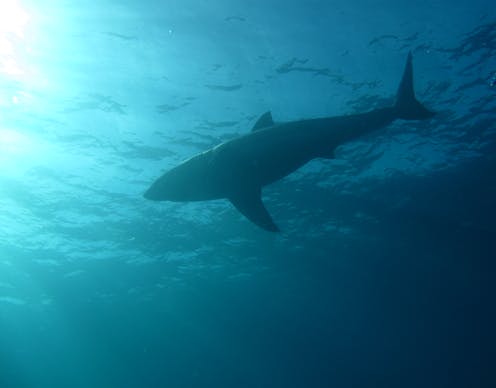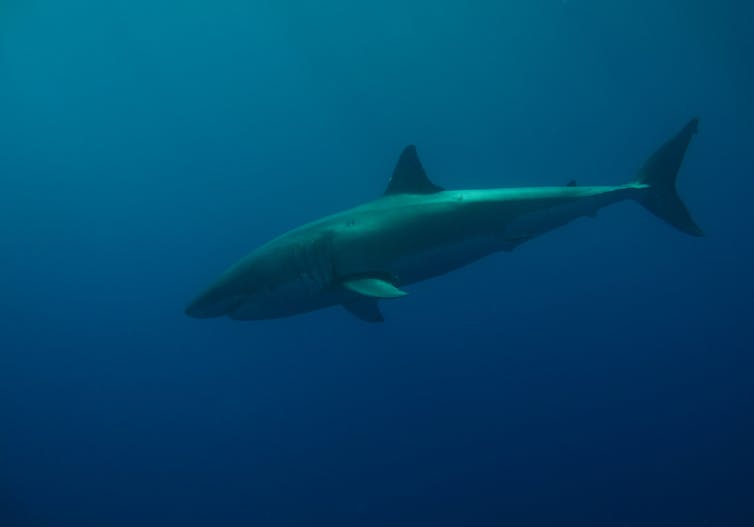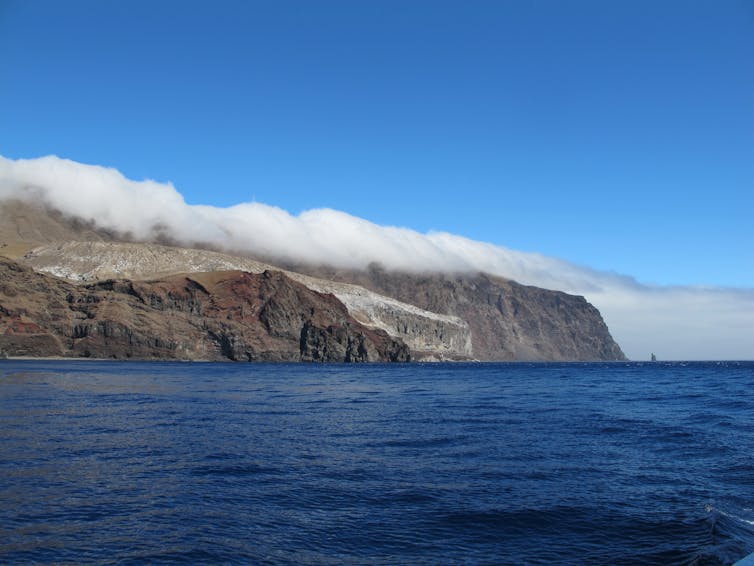Great white sharks occasionally hunt in pairs - new research sheds light on social behavior of these
Researchers have discovered that great white sharks are more social than previously thought. Using specialized tags, they tracked six sharks and found that some stay close to each other when hunting.

Sitting anchored to the rocky reef 70 feet (21 meters) below the surface of the ocean, hundreds of scalloped hammerhead sharks swam above me in unison, moving as if one. When most people think of sharks, they don’t think of them as social creatures. The schooling hammerhead sharks above my head were a striking example of shark social groups, a topic that has not been the subject of much exploration.
I am a marine biologist and study the behavior of predators. For the last 22 years, my research has focused on sharks.
Biologists have long known that some sharks – like hammerheads – are social creatures, but whether great white sharks interact with each other while hunting, and if so, how, is still a mystery. Since 2014, my colleagues and I have visited the beautiful Guadalupe Island off the coast of Mexico to try to find out. Using state of the art technology, we have been able to gain a better understanding of the secret social lives of these top predators.
What makes a social animal?
A social animal is one that interacts and spends time with other individuals of the same species. While nearly all animals show some degree of sociality – when they mate, for example – social behaviors can range from solitary snow leopards to highly social ant colonies.
When people think of social predators, most probably picture a pack of wolves hunting in an organized, cooperative group. But social behavior can be much simpler than that. An animal may simply decide to stay in close proximity to another individual because it has learned that if its “colleague” locates some prey, its own chances of getting a meal increase.
The sharing of information – the location of prey – in this example is inadvertent. The first predator wasn’t purposefully alerting the second predator to the presence of a meal. But under the right conditions, this type of basic social interaction can increase the success of both animals’ hunting.

Hints of a social shark
White sharks travel to seal colonies during the seal’s breeding seasons in the summer and fall. Sharks generally hunt by patrolling the waters adjacent to seal colonies and ambush seals at the surface.
In 2001, researchers in California published a paper describing how white sharks patrolling a seal colony at Año Nuevo Island would remain within “eavesdropping” distance of each other. The biologists suggested that if one shark killed a marine mammal, other, nearby sharks would register this information and quickly approach the site of the kill, perhaps hoping to eat from the remains of the prey. While the sharks may not be cooperating, they can still potentially benefit by hanging out with each other.
Further studies on white shark behavior in Australia took this a step further. Researchers found that white sharks would often turn up at cage diving sites with the same individuals time and time again. The fact that white sharks not only stay close to each other but also have preferred buddies got me wondering if maybe these animals were more social than people thought.

How to tag a great white shark
Guadalupe Island is located about 150 miles (240 km) west of Mexico’s Baja Peninsula. Every fall, at least 100 white sharks arrive at the island to feed on Guadalupe fur seals, California sea lions, squid and tuna. In 2014, I reached out to my friend and colleague, Mauricio Hoyos-Padilla, who has been tagging white sharks at Guadalupe for over 15 years, to see if he was interested in studying white shark social behavior.

To do this, we developed a new electronic tag that we call the “social tag.” It has sensors that can detect simple acoustic transmitters that we attached to other sharks, allowing us to see which sharks hang out with each other and for how long. The social tags also include a video camera and motion sensors that can track how fast the shark is swimming and how deep it is.
Starting in 2017, I would head to Guadalupe every year for about a week to try to tag sharks with Mauricio and his students from the nonprofit research organization Pelagios-Kakunja. Sometimes we would tag sharks from the safety of cages, but more often we would free dive with them. We would use bait to attract a shark to the boat and when one appeared, three or four taggers would jump into the crystal clear water. We would then wait for one of these large sharks to get curious and swim within a few feet of us. When that happened, we would use a long pole to clamp the tag onto the dorsal fin of the shark.
Over three years of successful tagging, we deployed our social tags on three male and three female sharks and tagged another 37 individuals with acoustic transmitters. The tags would stay on for one to five days before falling off and floating to the surface for the team to recover. In total, we collected over 312 hours of data from the six social tags.
When sharks hang out
Over the many hours of data that we collected, the sharks frequently came within 100 feet (30 meters) of other individuals. Many of these meetings were short and seemingly random – kind of like crossing paths with someone at a grocery store – but a few lasted longer and appeared to be true social interactions. We recorded five instances of these longer interactions, one of which lasted for over an hour.
We also found that individual sharks behaved quite differently from one another. Two of the tagged sharks were particularly social and associated with 12 and 16 other individuals, while two others appeared much less social, only crossing paths with only four and six other sharks respectively. The tags used on the final two sharks did not have working sensors on them, so we were not able to measure interactions.
Another interesting behavioral difference was that some sharks hunted in shallow waters and others hunted hundreds of meters deep.
Our new evidence suggests that white sharks are indeed social animals. Just as previous research suggested, our results fit with the idea that that the benefit of white shark sociality is that they can “eavesdrop” on other sharks. They can quickly acquire information such as a seal killed at depth by another shark, and this could end leading to an easy meal. However, there is so much more to learn.
Measuring sociality over months and over a year, as opposed to just days, would provide much deeper insights. When the sharks leave Guadalupe Island in the spring, they travel long distances across the open ocean – some swim as far as Hawaii. Do they travel together or by themselves?
The social lives of white sharks have been a secret hidden from researchers for decades. It took new technology and new research methods to see it.
Yannis Papastamatiou receives funding from Sharkproject International and Great White Mystery.
Read These Next
What’s at stake in Trump’s executive order aiming to curb state-level AI regulation
In the absence of comprehensive federal AI regulation, states have stepped in. The Trump administration,…
The Bible says little about Jesus’ childhood – but that didn’t stop medieval Christians from enjoyin
Legends about Jesus’ early years that circulated in medieval Europe often drew on apocryphal texts.
Sleep problems and depression can be a vicious cycle, especially during pregnancy − here’s why it’s
Inadequate sleep can have negative downstream effects on everyday cognitive functioning and mental health,…





